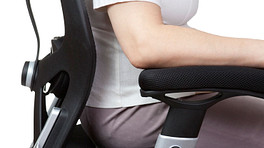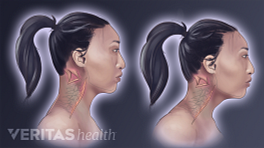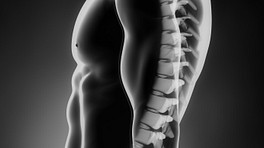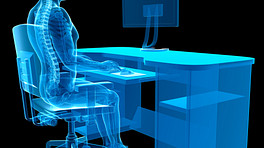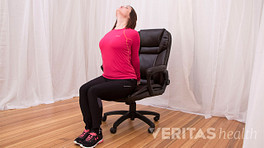While the spine can maintain a natural curvature without lower back support provided by the seatback, the natural tendency for most people when sitting for a long period is to slouch forward. This slouching posture pushes the lower back out, so that the natural inward curve goes in the opposite direction - outward toward the chair - straining the structures in the lower back.
Maintaining Back Support in an Office Chair
When sitting in an office chair, a good lumbar back support should be flush against the small of the back. Many portable lumbar back supports are shaped specifically so that one end should be positioned up and the other down. When placed correctly, a lumbar back support should provide the following benefits:
- Ears, shoulders, and pelvis (hips) are kept in alignment
- Natural inward curvature of the lower spine is maintained
It is important that the back be flush, because this is what provides the support for the lower back. Overall, the lumbar back support should keep the spine in a very natural position. It should not overly accentuate the inward curve, nor should it feel unsupported.
Back Support and Ergonomic Chair Options
There are several types of lumbar back supports available in different types of office chairs:
-
Ergonomic chair. There are a number of ergonomic chairs that are ergonomically sculpted with a lumbar support curvature built into the chair. To test if the ergonomic chair fits well, the user should sit up straight, with the head, spine, and buttocks in alignment. Then sit all the way back against the seatback. The curve of the ergonomic chair should naturally follow the curve of the lower back.
Because this type of lumbar support is not adjustable, the ergonomic chair should be tested and examined prior to usage to ensure an appropriate fit.
In This Article:
- Office Chair Back Support
- Types of Lumbar Support and Ergonomic Office Chairs
- Adjustable back support chair. Many office chairs have a seatback that can be lowered or raised to better fit the user. The seatback should be positioned so that the curve of the lower spine is supported by the curve in the back of the chair. If more than one person will use the chair, then this level of adjustment may be a good option.
- Portable lumbar back support. A curved cushion or lumbar roll, fitted to the seat back of an office chair, can be manually placed to fit the proper areas of the lumbar region. These cushions can be used in conjunction with most types of chairs to best fit the individual's need. Some products may be inflatable to increase or decrease the amount of support. Again, many portable lumbar supports are designed to have a particular end facing up and the other down. This type of support may be transferred to the office chair, to use in chairs at home, in the car, etc.
- A towel or small pillow. In many circumstances, a commercial lumbar back support is not necessary and a rolled up towel or small pillow may serve this function well. By rolling or folding a towel to the desired thickness, this support is placed wherever the user deems fit for the most comfort and support while sitting in an office chair.
In addition to good back support while sitting, it's best to try to avoid sitting in the same position for more than thirty minutes at a time. If possible, stand up, stretch, and walk around a bit before returning to the sitting position.

